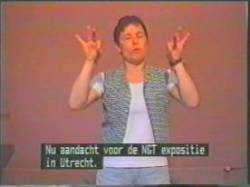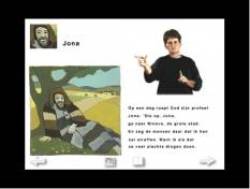17. Subtitles, captions, text
SummarySubtitles, captions, and other printed texts can be used to support and in some cases to replace sign language or a voice-over in signing books.Subtitles (lines of text in the bottom of the screen) should reflect faithfully what is being said / signed. Timing, language level, and the extent to which texts are abbreviated or simplified will depend on the target group and the objective of the production. Captions (texts on the screen) can be used for names, difficult words, new words, and/or to support fingerspelling.In educational productions, printed texts can be included with a video or CD-ROM to help the viewers make the transition from signed to printed language. Subtitles, captions and texts should be clearly visible, even for low-vision viewers. They should not interfere with the visibility of the sign language and should not distract the user who knows sign language. In interactive media (CD-ROM, DVD) the user should be able to choose whether or not captions are visible, and if they are visible, they should be allowed to select the style (size, colour, speed, location). |
||
SubtitlesSubtitles show what speakers say, and/or what signers sign, in printed language. Subtitles are usually shown in the bottom part of the screen. In the USA, subtitles are called 'captions'. Open subtitles or captions are visible for everyone, closed subtitles or captions are hidden and only visible on television sets that have a teletext decoder.
CaptionsThe term captions may also be used to refer to labels, names, and other printed texts on a video.
Printed textSome videos and CD-ROMs include text-screens, alternating with or in combination with a signer.
For hearing peopleSubtitles for hearing people are usually 'open' subtitles, visible for everyone. They are usually in a white font, with a black outline, against a transparent background. They represent everything that is being said - or as closely as time and space allows. In many countries (e.g. the Netherlands), national subtitles are added to all foreign video and television programmes, to make them accessible for all viewers. In other countries (e.g. Germany), almost all foreign programmes are 'dubbed': the voices of the foreign actors are replaced by voices of actors speaking the national language.
Subtitles for hearing people rarely if ever include information about the source of a text (e.g. which actor is speaking?), or about background sounds or music.
For Deaf peopleSubtitles for Deaf and hard-of-hearing people can be 'closed', or 'open'. Different colours can be used for the font, to indicate different speakers. The captions are usually shown against a black background. They usually include information as to the speaker (colour coded, or named explicitly, or by captions being centred underneath the speaker), as well as with respect to music, environmental sounds, and even: the absence of sounds. In some countries, subtitles for Deaf people use simplified language, and/or are simplified as to content.
Subtitles can appear as 'pop-on' lines, 2 or 3 lines on the screen that 'pop on' as whole units, or as 'roll-up' lines, with two to four lines on continuous display. As each new row appears at the bottom of the display, the display scrolls up one row, and the top row disappears.
Instead of sign languageIn some productions, subtitles may be used instead of sign language for all or some of the information. Subtitles should not be used for productions for children under 10, because they will probably not read well enough to understand the subtitles.
To support sign languageSubtitles can be added to videos in sign language to make these accessible for hearing viewers. They can also be used for Deaf viewers, if a video uses many new, or unfamiliar signs. Subtitles underneath the signer may also be appreciated by Deaf and hearing people who are not (yet) fluent signers.
On the other hand, some Deaf viewers find subtitles distracting, and feel that they interfere with the sign language.
To support fingerspellingNames, technical terms, and unfamiliar words are often fingerspelled. Captions, text-screens, and/or labels can be used to support (or even replace) the fingerspelling.
For navigationCaptions and textscreens can also be used for navigation purposes, e.g. for chapter headings.
To support readingIn some interactive CD-ROM productions for children and students, the signer is shown alongside the text that is being signed. The viewer can watch the sign language, read the printed text, or do both. The sign language can help the viewer understand the content of the message, and the printed text can introduce the viewer to the words and language used to express the content in printed and spoken language. For other viewers, the opposite may be true: the printed text will convey the meaning, while the sign language introduces the viewer to the signs and sign language that can be used to transmit this meaning.
To satisfy copyright regulationsWhen a video is a translation of a printed book, e.g. a printed story-book for children, the publisher of the original publication may require that the signing book contains exactly the same information and the same language as the printed book. Since the sign language may deviate a little or a lot from the printed language in the book, the printed language can be included as text-screens in the production to meet this requirement.
For foreign signing booksA video produced in a foreign sign language can be made accessible by adding subtitles in the national language. For foreign sign language productions, most Deaf people prefer subtitles to a translation added in the national sign language, because they find it very difficult and very confusing to watch two different signers and two different sign languages shown simultaneously, side by side, on the screen.
All subtitlesFor all productions with subtitles, the producer will have to decide whether or not to include subtitles, and if subtitles are included:
Subtitles in signing booksIf subtitles are added to a production in sign language, the producer will have to decide what text to use for the subtitles and the relationship between the subtitles and the signer (in time and in content) and between the subtitles and the voice-over. Some production teams use the original written text as the source text for captions, others use a 'back-translation' from the sign language. If the captions are to be synchronised with the sign language, abbreviations in the source text may be necessary. If a video has a voice-over and subtitles, these should be synchronised as much as possible in time and content.
In interactive productionsIn interactive productions, the user should be able to select whether or not captions are shown, and if they are shown, the user should be able to select the size and the colour of the font. On DVD, the user may also be able to select what language subtitles should be in.
Visually impaired viewers!For visually impaired viewers, the preferred colour for subtitles and captions is white against a black background.
|
EXAMPLESCaptions Chapter heading, in print and in sign language. Verschillende aspecten van de Vlaams-Belgische Gebarentaal, Fevlado, BE Chapter heading, in print and in sign language. Verschillende aspecten van de Vlaams-Belgische Gebarentaal, Fevlado, BE Names: in print and in fingerspellingSigning Books prototype, Hamburg University, DE Names: in print and in fingerspellingSigning Books prototype, Hamburg University, DE
 In large print: the name of the speaker (the man in the small box on the left) in small print, the name of the interpreter (the woman in the large box). Kuurojen Video, FI In large print: the name of the speaker (the man in the small box on the left) in small print, the name of the interpreter (the woman in the large box). Kuurojen Video, FI
SubtitlesThe Deaf children (90 children, 7-19 years of age) who participated in one of the Signing Books user tests compared two video-clips of a signer signing a story in SLN. The first clip had no captions, the second clip did have captions. Almost all children (90%) preferred the captioned clip. The children said they could watch the signer and read the captions at the same time, and that the captions helped them understand the sign language better (see Del. 6.1).
For foreign sign language productions, most children preferred captions to a bubble with a sign language translation.
  Closed subtitles: white font against black background. Videokrant Dovenschap, NL Closed subtitles: white font against black background. Videokrant Dovenschap, NL
 Open subtitles, white font, against a semi-transparent grey background. Signer and subtitles overlap but don’t interfere. See Hear, GB Open subtitles, white font, against a semi-transparent grey background. Signer and subtitles overlap but don’t interfere. See Hear, GB
 Open captions, white font against black background. Not overlapping with video or signers. Human Rights, Fischer Film, AT Open captions, white font against black background. Not overlapping with video or signers. Human Rights, Fischer Film, AT
Printed texts De Kijkbijbel (Effatha, NL): A CD-ROM for young deaf children with pictures, printed text, and a signer presenting the story (top right). De Kijkbijbel (Effatha, NL): A CD-ROM for young deaf children with pictures, printed text, and a signer presenting the story (top right).
 Mini Vejledning (Ministry of Education, DK), a video with a signer, alongside the printed text that is signed. Mini Vejledning (Ministry of Education, DK), a video with a signer, alongside the printed text that is signed.
 The same text as above, but now produced on CD-ROM, with additional navigation buttons (Ministry of Education, DK) The same text as above, but now produced on CD-ROM, with additional navigation buttons (Ministry of Education, DK)
|
|
